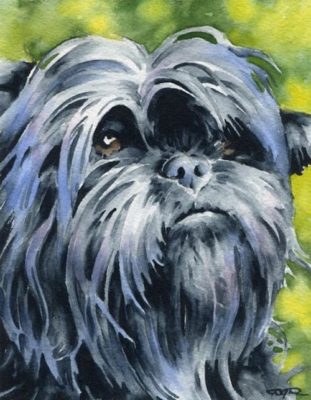
An Affenpinscher may have any eye shape as long as it’s round.
In some breeds, round eyes are undesirable because they are more prone to getting damaged by brush, branches or dirt when hunting, treeing, or digging into a tunnel. While early use of the Affen was as an urchin-like stop-gap for vermin in kitchens, granaries, and back rooms (this at a time when the breed stood 12 to 15 inches at the withers, and not the 9-11 inches of today’s Affenpinscher), the breed morphed into becoming the companion and lapdog of upper class society, and that status may have led to the down-sizing of the breed. What didn’t change was the dog’s expression.
As respected judge, Beth Sweigart, once wrote with regards to evaluating the breed: “Is this a monkey like character? He should be. His eyes should be dark and expressive, neither too large giving him the look of a griffon or too small which also creates a look of a foreign expression.”
Much of that expression comes from those human-like eyes framed by bushy eyebrows.
Owners “fell” for the Affen’s expression long before research proved that people like dogs whose faces resemble people. Jeffrey Schoenebeck, a research fellow at the National Institutes of Health who analyzed the development of shortened canine muzzles said that these eyes mimic the way humans appear. Additional studies found that dogs have evolved muscles around their eyes which allow them to make expressions that particularly appeal to humans. A small facial muscle allows dog eyes to mimic an “infant-like” expression which prompts a “nurturing response.”
Add to this the eyebrows. Behavioral psychologist, Juliane Kaminski, of the University of Portsmouth said, “When dogs make the movement, it seems to elicit a strong desire in humans to look after them. This would give dogs that move their eyebrows more, a selection advantage over others and reinforce the ‘puppy dog eyes’ trait for future generations.” Previously, Kaminski and her team demonstrated that dogs actually do make facial expressions as a means of communicating with humans by studying their behavior when a human was facing towards them, compared to facing away. The team found that dogs used facial expressions far more when the human was looking at them.
Bottom line: We humans never had a chance.
Image: Affenpinscher by DJ Rogers – k9artgallery
http://dogprintsgallery.com
www.etsy.com/shop/k9artgallery
